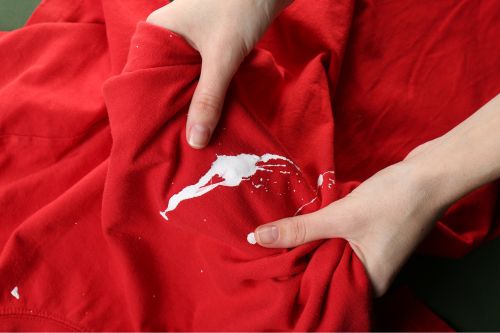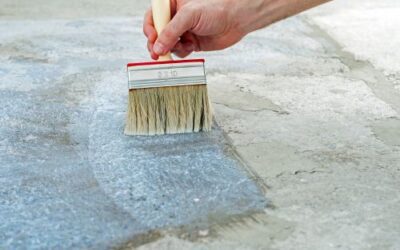Dried paint stains are common in renovation projects and can be a challenge to remove. But with the right methods and tools, you can get rid of them without damaging the affected surfaces. In this article, we’ll guide you through several effective techniques for removing dried paint stains from different surfaces.
Removing paint stains from clothing
Pre-treat the stain
Before attempting to remove paint from clothing, it is crucial to pre-treat the stain. For water-based paints, soaking the garment in warm water can help loosen the paint. For oil-based paint, applying a solvent such as turpentine or mineral spirits will be more effective. It is important to treat the stain as soon as possible to prevent it from adhering further to the fabric. Gently scrub the stained area with an old toothbrush or clean cloth to begin to loosen the paint.
Washing and removal techniques
Once pre-treated, you can begin to wash the garment. For water-based paints, apply a mild detergent and rub gently. For oil-based paint stains, use a specialised stain remover. You may need to repeat the process several times to completely remove the paint. Then wash the garment according to the care instructions. If any paint residue remains, try not to dry the garment until the stain is completely removed, as heat can set the stain.
Contact our professionals to paint your home
Removing dried paint from wooden surfaces
Using scrapers and spatulas
Removing dried paint from wood requires care to avoid scratching it. Start by using soft tools such as plastic scrapers or putty knives. It is best to use gentle, controlled strokes to lift the paint. If you encounter resistance, do not apply too much force, as this may damage the surface of the wood.
Solvents and cleaning products
If the paint is still adhering, consider using solvents such as turpentine or a specialised cleaner. Apply the solvent to a clean cloth and wipe over the paint stain, allowing it to work for a few minutes. Then gently wipe the area with the cloth. Remember to test a small area first to make sure the solvent will not damage the wood finish. After removing the paint, clean the surface with mild soap and water to remove any solvent residue.
Removing paint from metal surfaces
Mechanical removal methods
For metal surfaces, starting with mechanical tools such as sandpaper or wire brushes can be effective. These tools can remove layers of paint without causing significant damage to the metal, but it is important to proceed carefully to avoid scratching the surface. Applying moderate pressure and controlled movements are key to gradually removing the paint. In certain cases, if the paint is not too adherent, these methods may be all you need.
Solvents suitable for metals
If you need a less abrasive approach or if the paint is tough, solvents designed for metals can be an excellent option. Applying products such as turpentine or specific paint removers can help dissolve the paint, making it easier to remove. Leave the solvent on for a few minutes, then gently wipe off with a clean cloth or sponge. It is vital to follow the manufacturer’s instructions and take precautions such as wearing gloves and working in a well-ventilated area. Wipe the surface with a dry cloth to remove any solvent residue.
Removing dried paint from plastic surfaces
Gentle techniques for plastics
Plastic requires careful treatment due to its susceptibility to damage from chemicals or abrasive tools. Start by applying a solution of warm water and mild soap and use a sponge or soft cloth to rub the stain. This simple method can be effective in softening and removing the paint without damaging the plastic.
Using isopropyl alcohol
If the stain persists, isopropyl alcohol can be a safe option. Apply the alcohol directly to the stain and allow it to work for a few minutes before gently rubbing the area with a soft cloth. Isopropyl alcohol is effective at dissolving paint and is generally safe for use on plastics. However, it is always advisable to test a small area to make sure it will not damage the material.
Dealing with paint stains on glass surfaces
Scrapers and suitable blades
Glass allows a certain degree of freedom to use tools such as scrapers or blades, but always be careful not to scratch. These tools are effective for scraping off dried paint, and you can help with a little water or glass cleaner to lubricate the surface. Use careful, controlled strokes to remove the paint, avoiding applying too much pressure that could cause damage.
Glass cleaners and mild solutions
After removing most of the paint with the squeegee, glass cleaners can be useful to remove any residue. These products are formulated to be effective at dissolving substances such as paint, while being gentle on the glass. Apply the cleaner and use a soft cloth or paper towels to wipe the surface. These products will not only help to remove paint residue but will also leave the glass shiny and streak-free.
Other publications that may interest you
How to prepare a house for painting without causing chaos and staining
Proper preparation saves time, avoids splashes and allows paint to adhere better. Follow this plan - tested by Bartolomé Bas's team of house painters - and you will achieve an impeccable finish without turning your home into a war zone.Clear and organise the room...
Exterior floor paint: what type to use and how to apply it correctly
Protecting an exterior floor - terrace, porch, garage or pedestrian access - is not just about aesthetics: it prevents cracks, leaks and premature wear and tear. Choosing the right exterior floor paint and applying it methodically ensures a durable and...
How to know if the humidity in your house is due to condensation, filtration or capillarity
The stain you see on the wall does not always have the same origin, and making a mistake when it comes to treating it can make the problem worse and make the repair more expensive. Below you will learn how to differentiate the three most frequent sources of damp and...




